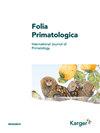Canopy bridges are an economical mitigation reducing the road barrier effect for three of four species of monkeys in Diani, Kenya
IF 0.8
4区 生物学
Q2 ZOOLOGY
引用次数: 5
Abstract
For primates, canopy bridges can reduce the road barrier effect. Yet little information exists to predict species bridge use. We examined bridge use across a 9 km suburban road in Diani, Kenya, in three survey years (Nbridges: 21 = 2004, 27 = 2011, 29 = 2020) by four sympatric species of monkeys. The asphalt road is 6 m wide with a 50 km/h speed limit. Roadside observers recorded ground () and bridge () crossings, crossing direction, and traffic volume. Colobus (Colobus angolensis palliatus), Sykes’ monkeys (Cercopithecus mitis albogularis), and vervets (Chlorocebus pygerythrus hilgerti) used the bridges while baboons (Papio cynocephalus cynocephalus) rarely did. Crossing rates (Sykes’>vervet>colobus>baboon) did not fit our predictions based on species’ attributes of stratum preference (arboreal>terrestrial) or body mass (small>large), while the interaction between these attributes was more informative. Crossings were bidirectional. Colobus crossed bridges during higher traffic volumes than on the ground, whereas we found the opposite for vervets. Sykes’ monkeys crossed at similar traffic volumes on the ground and bridges. The mean annual bridge cost was USD 157, deriving a cost per crossing as < USD 0.10, though it undervalues the savings in ecosystem services, tourism benefits, and contributions to protecting colobus, a vulnerable species. While we consider this highly economical, funders and road engineers will ultimately determine if it is so.树冠桥是一种经济的缓解措施,减少了肯尼亚迪亚尼四种猴子中三种的道路障碍效应
对于灵长类动物来说,雨棚可以减少道路屏障的影响。然而,几乎没有信息可以预测物种桥梁的使用。我们在三个调查年(Nbridges:21=2004,27=2011,29=2020)中,通过四种共病猴子,研究了肯尼亚迪亚尼一条9公里郊区道路上的桥梁使用情况。柏油路宽6米,限速50公里/小时。路边观察员记录了地面()和桥梁()的交叉口、交叉方向和交通量。Colobus(Colobus angolensis palliatus)、Sykes猴(Cercopithecus mitis albogularis)和vervets(Chlorocebus pygerythrus hilgerti)使用桥,而狒狒(Papio cynocephalus cynocepharus)很少使用桥。杂交率(Sykes’>vervet>colobus>baboon)不符合我们基于物种的地层偏好(树栖>陆地)或体重(小>大)属性的预测,而这些属性之间的相互作用信息更丰富。十字路口是双向的。Colobus在交通量高于地面的情况下过桥,而我们发现vervets的情况正好相反。赛克斯的猴子在地面和桥梁上以类似的交通量穿过。桥梁的年平均成本为157美元,得出每次穿越的成本<0.10美元,尽管它低估了生态系统服务、旅游效益的节约以及对保护疣猴这一脆弱物种的贡献。虽然我们认为这非常经济,但资助者和道路工程师将最终决定是否如此。
本文章由计算机程序翻译,如有差异,请以英文原文为准。
求助全文
约1分钟内获得全文
求助全文
来源期刊

Folia Primatologica
生物-动物学
CiteScore
3.30
自引率
10.50%
发文量
36
审稿时长
>12 weeks
期刊介绍:
Recognizing that research in human biology must be founded on a comparative knowledge of our closest relatives, this journal is the natural scientist''s ideal means of access to the best of current primate research. ''Folia Primatologica'' covers fields as diverse as molecular biology and social behaviour, and features articles on ecology, conservation, palaeontology, systematics and functional anatomy. In-depth articles and invited reviews are contributed by the world’s leading primatologists. In addition, special issues provide rapid peer-reviewed publication of conference proceedings. ''Folia Primatologica'' is one of the top-rated primatology publications and is acknowledged worldwide as a high-impact core journal for primatologists, zoologists and anthropologists.
 求助内容:
求助内容: 应助结果提醒方式:
应助结果提醒方式:


